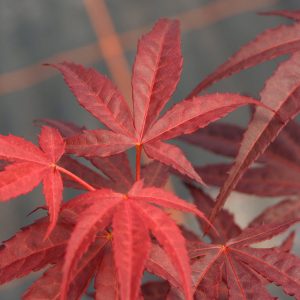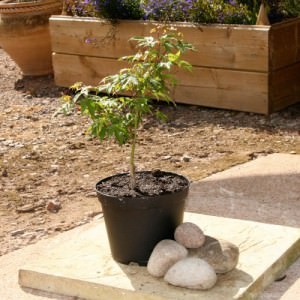Japanese Maple Quick Facts:
- Full name: Acer palmatum
- Hardiness: Fully hardy. Should thrive across most of the UK and Ireland
- Form: Small tree/Shrub
- Height when mature: 8-10 ft / 3 m
- Spread when mature: 5 ft / 1.5 m
- Suitable for: planting and pot growing
- Difficulty: Easy
 Japanese Maples are small deciduous trees native to the Far East. In Japan, they are known by the name ‘Kito, and have become synonymous with calm, peace and rest. Highly valued for their graceful aesthetics, planting one symbolises that you are welcoming Autumn as a friend.
Japanese Maples are small deciduous trees native to the Far East. In Japan, they are known by the name ‘Kito, and have become synonymous with calm, peace and rest. Highly valued for their graceful aesthetics, planting one symbolises that you are welcoming Autumn as a friend.
The formal name for this deciduous tree is Acer Palmatum, named by a Swedish Botanist in the late 1700’s for its hand-shaped leaves. The Enkan is one of the most popular varieties of Japanese maple because of its spectacular colouration through Spring Summer and Autumn; the delicate leaves range from red-orange to deep red-purple. It is a small sized tree which is suitable for most gardens.
Enkan Japanese Maple trees are a great choice for a novice gardener as acers are easy to grow, but their graceful shape and beautiful foliage make a big impact on a garden.
Planting
Choosing the correct planting site for a Japanese Maple is one of the most important factors that will ensure your tree grows up happy and strong. Japanese Maples naturally grow under a canopy in woodland areas, so are naturally suited to dappled sunlight and shade. Try to reflect this environment in the site you choose for your maple, as full summer sun can scorch new leaves.
Your Japanese maple will be happiest if it is planted into slightly acidic, sandy soil but will do well in almost all types provided they are well drained – maples hate wet feet! It is a good idea to test the drainage first by digging a hole 12” deep and wide, then fill with water. If this drains completely in around 6 hours, it is well drained. If this drains in 6 - 12 hours, it is moderately drained and anything over 12 hours is poorly drained soil.
When planting your Japanese maple:
- Remove the maple tree from its pot
- dig a hole that is the twice the depth of the roots and three times the diameter
- scrape away some of the excess compost surrounding the tree's roots so the natural shape of the root system is exposed
- add some organic compost to the soil you removed from the hole
- plant the tree, placing soil all around the roots to eliminate air pockets.
- Firm down the soil, but be careful not to pack the soil around the tree too firmly.
- use a supporting stake
- water immediately and thoroughly
For the first two years after planting, water your Japanese maple regularly so the ground is damp, but not waterlogged. Mulch the ground around your tree every couple of years with well-rotted manure or compost.
Repotting
 Japanese Maples can be grown in pots as well as in the ground. If you are planning to keep your Japanese Maple as a potted plant, then it will need repotting into a larger pot within a year of receiving it. The best time for repotting your plant is October - March when the tree is in a dormant state and the roots are not growing.
Japanese Maples can be grown in pots as well as in the ground. If you are planning to keep your Japanese Maple as a potted plant, then it will need repotting into a larger pot within a year of receiving it. The best time for repotting your plant is October - March when the tree is in a dormant state and the roots are not growing.
A fantastic small variety for growing in a container is the Acer Little Princess, it's slow growing with a compact growth habit. The delicate leaves have seasonal interest throughout the year making it a wonderful addition to the garden.
Some tips for repotting
- the soil in the Japanese Maple tree pot should be slightly moist; water thoroughly an hour before repotting to achieve this.
- loosen the soil around the edge of the pot and pull the tree out by the base of the main stem
- if you are moving your Japanese Maple tree to a bigger pot, add some extra soil into the bottom of the pot before you insert the plant
- fill in with a mix of soil and loam based compost, we recommend John Innes No.2. Fill it well but don’t pack the soil in too tightly, as this will restrict the circulation of oxygen around the roots, effectively strangling the tree.
- water the plant thoroughly, and keep it well watered for several weeks
As a general rule, repot your maple every couple of years into a larger pot, and add fresh loam based compost. Look out for the following signs that your Japanese Maple needs a new home:
- does your tree look less healthy than it used to
- does it seem to dry out quicker?
- are there roots growing out of the holes in the bottom of the pots?
- has the Japanese Maple tree been in the same pot for three years or more?
Feeding
If you are growing your Japanese Maple tree in a pot, feed your tree twice a year in spring and early summer with a balanced liquid fertilizer.
Mulching
 Mulching is the term used for the layer of organic material that is placed on top of the soil around your plants every year. It has a whole host of benefits, including keeping the soil moist throughout summer and discouraging blackspot and weeds. Ideally, mulch the ground around your Enkan Japanese Maple every two years in late Spring (April-May) or Autumn (October).
Mulching is the term used for the layer of organic material that is placed on top of the soil around your plants every year. It has a whole host of benefits, including keeping the soil moist throughout summer and discouraging blackspot and weeds. Ideally, mulch the ground around your Enkan Japanese Maple every two years in late Spring (April-May) or Autumn (October).
First, prepare the ground by removing debris and weeds and water the surface of the soil if it is dry, Apply a thin layer of well-rotted manure or good garden compost all around the tree - we suggest using John Innes No. 2. For Japanese Maple trees, please ensure that there is a gap of around 10cm between the tree and the mulched area.
Watering
For the first two years after planting, water your Japanese maple regularly in hot weather so the ground is damp, but not waterlogged.
When trees are grown in containers, they will have more restricted access to water than those growing in the garden. so will need watering with greater regularity. Water your Japanese maple regularly so that it is evenly moist but not saturated. As a rule of thumb stick your finger into the first inch of topsoil and if it feels dry, water immediately.
Pruning
The Enkan Japanese Maple is a real easy care tree, as it hardly requires any pruning at all. It is generally agreed that the natural and graceful aspect of Japanese Maples is much more attractive than any shape created by pruning. You may occasionally need to trim off dead or excess branches; this is best carried out in winter.
Winter Care
The roots of a pot grown Japanese Maple are liable to freeze in winter, so wrap the pot in some protective bubble wrap to prevent this from happening


